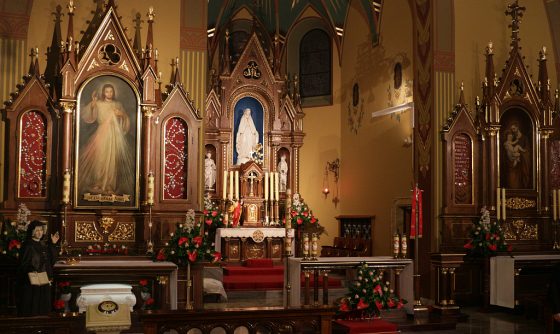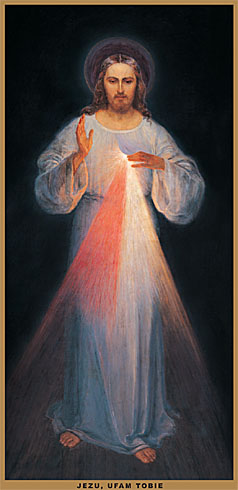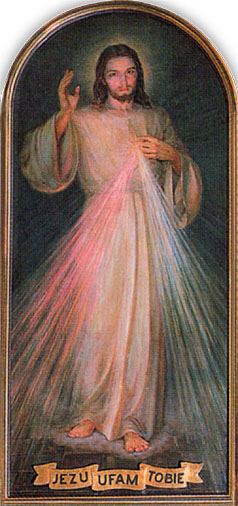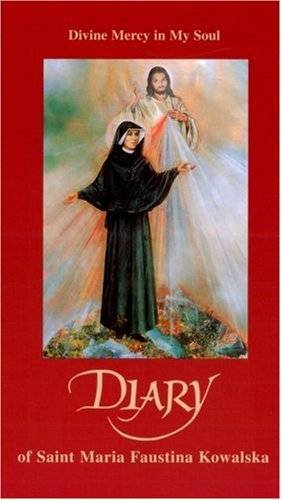

On February 22, 1931, Jesus Christ our Lord appeared to St.
Faustina in a vision.
"In the evening , when I was in my cell, I
saw the Lord Jesus clothed in a white garment. One hand [was]
raised in the gesture of blessing, the other was touching the
garment at the breast. From beneath the garment, slightly
drawn aside at the breast, there were emanating two large rays,
one red, the other pale. In silence I kept my gaze fixed on the
Lord; my soul was struck with awe, but also with great joy.
After a while, Jesus said to me,"
"Paint an image according to the
pattern you see, with the signature: Jesus, I trust in You. I
promise that the soul that will venerate this image will not
perish. I also promise victory over [its] enemies already here
on earth, especially at the hour of death. I Myself will defend
it as My own glory (Diary, 47, 48). I am offering
people a vessel with which they are to keep coming for graces to
the fountain of mercy. That vessel is this image with the
signature: Jesus, I trust in You (Diary 327). I desire that this
image be venerated, first in your chapel, and [then] throughout
the world." (Diary 47).
"I promise that the
soul that will venerate this image will not perish. I also
promise victory over [its] enemies already here on earth,
especially at the hour of death. I Myself will defend it as My
own glory." (Diary 48)
At the request of her spiritual director, St. Faustina asked the
Lord about the meaning of the rays in the image. She heard Jesus
reply:
"The two rays denote Blood and
Water. The pale ray stands for the Water which makes souls
righteous. The red ray stands for the Blood which is the life of
souls. These two rays issued forth from the depths of My tender
mercy when My agonized Heart was opened by a lance on the Cross.
Happy is the one who will dwell in their shelter, for the just
hand of God shall not lay hold of him (299). By means of this
image I shall grant many graces to souls. It is to be a reminder
of the demands of My mercy, because even the strongest faith is
of no avail without works." (Diary 742).
These words indicate that the Image
represents the graces of Divine Mercy poured out upon the world,
especially through Baptism and the Eucharist.
Many different versions of this image have been painted, but our
Lord made it clear that the painting itself is not what is
important.
When St. Faustina first saw the original
image that was being painted under her direction, she wept in
disappointment and complained to Jesus:
"When I visited the
artist [
Eugeniusz
Kazimirowski]
who was painting the image, and saw that
it was not as beautiful as Jesus is, I felt very sad, but I hid
this deep in my heart. When we had left the artist's house,
Mother Superior [Irene] stayed in town to attend to some matters
while I returned home alone.I went immediately to the chapelnd
wept a good deal, I said to the Lord, " Who will paint you as
beautiful as You are?" Then I heard these words:"
"Not in the beauty of the colour, nor of the brush lies
the greatness of this image, but in My grace.”
(Diary
313).
In answer, she heard these words:
"Not
in the beauty of the color, nor of the brush lies the greatness
of this image, but in My grace" (Diary 313).
Therefore, regardless of which version of the image we prefer,
we can be comforted in knowing that it is a vassle of God’s
grace if it is venerated with trust in His mercy.
The
Image of Divine
Mercy
by
Adolf Hyla
(The Hyla Image)
In 1943 – ten years
after painting the first image of Merciful Jesus in Vilnius and
five years after the death of Sister Faustina in Cracow - a fine
painter, Adolf Hyła, came to the Congregation of the Sisters of
Our Lady of Mercy in Cracow Łagiewniki. He desired to paint some
image as a gift for the monastic chapel as a token of gratitude
for saving his family from the war. The sisters suggested
painting the image of the Merciful Jesus.
They presented to the
artist a pattern - a replica of the first image painted by
Eugeniusz Kazimirowski in co-operation with Sister Faustina.
They also added its description from the Diary of Saint Sister
Faustina. Despite that, the artist completed the work according
to his own idea. Because the size of the painting did not fit
the altar in the sisters’ chapel, Mother Irena Krzyżanowska
ordered another painting. In 1944 the painting was blessed and
placed in the monastic chapel in Cracow where it has been
worshipped until the present day.
In this painting the Image of Merciful Jesus
was presented by the artist with the background of a meadow and,
visible in the distance, bushes. After the intervention of
Father Sopoćko in 1954, the background was painted over in a
dark colour and a floor was painted under the feet of the Lord
Jesus.
The painting donated by Adolf Hyła as a token
of gratitude was placed in the Heart of God parish church in
Wrocław (Poland). This church is linked to the monastic house of
the Sisters of Our Lady of Mercy.
After the end of World
War II, the first painting of the Merciful Jesus, painted by
Eugeniusz Kazimirowski in co-operation with Sister Faustina in
Vilnius, ended up in the territory of the USSR
where, due to barbarous oppressions,
thousands of people for several decades had to keep their faith
in God secret. The painting was also hidden, along with its
extraordinary origin.
Publicizing the other
image in Poland, perhaps providentially, steered attention away
from the miraculous “Holy Image” (as it was called in 1993 in
Vilnius by Saint Pope John Paul II), as at that time there were
no other, workable possibilities for saving the original image.
Also, numerous
unprofessional conservations, applying layers of overpaint, hid
for many years the artistic qualities of the image. A layer of
paraffin wax was applied by one of the restorers. Although it
served to a large extent as a protection against the effects of
humidity, in time it caused in the shades of the original
colours to change.
After a thorough conservation in
2003, removing all overpaints, the painting regained the clarity
of its message. The subtle figure of the Merciful Saviour
appearing in the dark space, directs the attention of prayerful
people to THE LIGHT OF THE RAYS OF MERCY emanating from His
Heart opened at the Cross.
Without a doubt, the
image painted by Adolf Hyła contributed to a great extent to the
growth of the Divine Mercy devotion. This is confirmed by
testimonials of the graces received through its intercession.
But its popularity did not detract from the value of the
original image painted in Vilnius –
precisely according to the guidelines given by Lord Jesus.
This image finally reached a time when it could be worthily
exposed at the high altar of the Sanctuary of the Divine Mercy
in Vilnius where, surrounded by the prayers of the Sisters and
visiting pilgrims, it has been worshipped publically ever since.
The History of the
Original Image of Divine Mercy by Eugeniusz
Kazimirowski
(The
Original Image)
At the beginning of
1934, Father Michael Sopoćko commissioned a Vilnius artist,
Prof.
Eugeniusz Kazimirowski, to paint the image of the Merciful
Jesus. Sister Faustina, who stayed in Vilnius during the whole
period of painting the image, visited the studio to pass on the
details. Father Sopoćko personally made sure that the image was
painted exactly according to her instructions. He fitted the
size of the canvas – on which the image was to be painted – to
the old frame he received from one of his parishioners. The
process of painting took about six months, and when the image
was ready, Father Sopoćko requested Sister Faustina to ask Jesus
how to position the inscription:
“Once, my
confessor (Father Sopoćko) asked me where the inscription
should be placed, because there was not enough space on the
painting for everything. I said I would pray and give him an
answer the following week. When I left the confessional and
was passing before the Blessed Sacrament, I received an
inner understanding about the inscription. Jesus reminded me
of what He had told me the first time; namely that these
three words must be clearly in evidence. These words are:
Jesus, I trust in You” (Diary,
327).
The dictated
inscription, which is a
significant part of the image,
was written on a separate board and placed at the frame beneath
the image. Then, as Lord Jesus explicitly requested through
Sister Faustina, Father Sopoćko started making efforts to place
the image in St. Michael’s Church in Vilnius, where he held the
post of a rector. As a result, on April 4, 1937, with the
consent of Metropolitan Archbishop of Vilnius Romuald
Jałbrzykowski, the painting of the Most Merciful Savior,
positively reviewed by experts, was hung next to the high altar
in St. Michael’s Church, where it was righteously worshipped by
the faithful for about eleven years.
The second committee of
experts, appointed at the Archbishop’s request in 1941, stated
that: “The image is painted in an
artistic manner and it constitutes a valuable contribution to
the contemporary religious art". (The Commission’s Report
on the assessment and conservation of the image of the Most
Merciful Saviour in the St. Michael’s Church in Vilnius dated
May 27, 1941, signed by the following experts: Professor of
History of Art, M. Morelowski, Professor of Dogmatic Theology,
Fr L. Puchaty, and the restorer Fr P. Śledziewski, PhD)
In 1948, after the St.
Michael’s Church was closed by the Soviet authorities, the
painting (without the frame and the inscription “Jesus, I trust
in You”) was secretly and illegally purchased from a Lithuanian
worker who was getting rid of the church’s furnishings. Two
women bought it (a Pole and a Lithuanian), worshippers of the
Divine Mercy. They were aware of the possible consequences they
could suffer from the hands of the Soviet authorities, so
removed the rolled-up painting from the church and hid it for
some time in the attic. Later on, it was passed on to the Church
of the Holy Spirit where all the movables from the closed church
had also been deposited. The parish priest of the Church of the
Holy Spirit, Father Jan Ellert was interested neither in keeping
the image nor in displaying it, so he hid it in the storage area
at the back of the church.
It was not until 1956
when the friend of Father Sopoćko, Father Józef Grasewicz,
returned to Vilnius after being released from a Soviet labour
camp, undertook to find the painting. He contacted Father
Sopoćko who was agonising over the lack of information about the
image of the Merciful Jesus. Father Grasewicz received
permission to resume his priestly service in Nowa Ruda. Before
leaving Vilnius, he asked the parish priest of the Church of the
Holy Spirit if he could move the painting to his parish in Nowa
Ruda. He received a positive response. So, Father Grasewicz
brought the painting to Nowa Ruda and placed it in the church
keeping its origin a secret.
Father Sopoćko
considered taking the painting to Poland, but he gave up his
efforts when it turned out that it would be dangerous. Despite
many changes in the administration of the church, the painting
stayed in Nowa Ruda for about thirty years.
In 1970, the local
communist authorities in Nowa Ruda decided to convert the church
into a warehouse. The furnishings from the closed church were
moved to another parish. However, the painting was left in the
deserted church for a seemingly trivial reason: it was hung high
up and the ladder they were using to remove objects was not long
enough to reach it. At that time Father Sopoćko, was in Poland
and he could do nothing to protect the painting. He remained
deeply concerned about it however and asked Father Grasewicz to
move it to another, safer place. However, it was not possible
for him to do so, as Father Grasewicz could not leave his
parish. All the priests in Belarus were too afraid to host the
painting. The painting of Merciful Jesus, was left for years in
that abandoned wooden church, surviving the dangerous era of
communism.
Father Sopoćko remained
concerned about the painting throughout his whole life.
Secretly, he sent numerous requests to move the painting to
Vilnius. He requested that the painting be placed at the Gate of
Dawn in Vilnius, where it was originally displayed to be
worshipped publicly. This request was not passed on until 1982
(already after the death of Father Sopoćko). When he received
it, Father Tadeusz Kondrusiewicz, then the priest at the Gate of
Down, refused and suggested placing the painting in the Church
of the Holy Spirit, where Father Aleksander Kaszkiewicz was the
parish priest. Initially hesitant, Father Kaszkiewicz eventually
agreed to hang the picture in the Church of the Holy Spirit. So,
Father Grasewicz made the decision to bring the painting back to
Vilnius.
To steer the
communists’ attention away from the extraordinary origin of the
painting, one November night in 1986, the original painting in
Nowa Ruda was secretly replaced with a copy prepared earlier.
The residents of Nowa Ruda, who gathered in prayer in the
abandoned church, were not aware of this. With the assistance of
the Sisters of the Mother of Mercy (from the Gate of Dawn), the
canvas was removed from the stretcher bar, rolled-up, and, the
same night, taken first to Grodno, and then to the Church of the
Holy Spirit in Vilnius.
In the Church of the Holy
Spirit, Father Kaszkiewicz ordered the restoration of the
painting. Damaged areas were covered with a new layer of the
paint. This substantially changed the appearance of the face of
Jesus. The red inscription “JESUS, I TRUST IN YOU” was added at
the bottom of the painting. Moreover, to fit the painting into
the recess in the altar, the bottom edge was folded-up and an
additional part added at the top.
The changes were
inconsistent with the artistic composition of the image painted
by Prof. Kazimirowski in collaboration with Sister Faustina and
Father Sopoćko. It was a drastic interference, which decreased
considerably the original value of the work.
The image being placed
in the side altar at the Church of the Holy Spirit in Vilnius,
was not of particular interest to either pilgrims or church
authorities. The lack of proper conditions for its exposition
had adverse physical effects on the image. It was not until July
2001 that, thanks to the courtesy of Father Mirosław Grabowski
the parish priest of the Church of the Holy Spirit, the
Congregation of the Sisters of Merciful Jesus was able to
establish a new centre in Vilnius to take proper care of this
unique and invaluable image of
Merciful Jesus, one that came into existence in an atmosphere
filled with God’s miracle making power – the prayer and
suffering of Saint Sister Faustina, in her presence and with her
participation.
Thanks to the efforts
and devotion of Sisters, in April 2003, a thorough restoration
of the painting was performed in the chapel of the sisters’
convent in Vilnius. All the overpaints and stains (resulting
from moisture and attempts of chemical cleaning) were removed.
As a result of this restoration, the original form of the
panting and the appearance of the image of Merciful Jesus were
restored.
Some of the defects in the painting canvas could only be
repaired by applying patches glued to the canvas on the
underside. This damage was the result of numerous removals of
the canvas from the stretcher bar (nail holes), and the
folding-up of about 4cm of the bottom part of the painting (in
1987, the painting was fitted in the altar in the Church of the
Holy Spirit). Although
invisible upon the painting’s display, these defects constitute
some of the characteristic features of the painting.
The painting was thoroughly restored and
returned to the Church of the Holy Spirit - the parish church
for the Poles living in Vilnius, in which Holy Masses and other
services are said only in Polish.
To create proper
conditions for individual contemplation - adoration of the image
of Merciful Jesus - for everyone, at any time, regardless the
origin and background - the Metropolitan Archbishop of Vilnius,
Cardinal Audrys Juozas Bačkis, decided to move the image of the
Merciful Jesus to a small neighbouring Church of the Holy
Trinity, which was converted into a Divine Mercy Sanctuary.
The circumstances
surrounding this event triggered controversial discussions in
all media publications and thus, unintentionally,
became a huge, positive promotion,
reminding people of the existence of the original image of the
Merciful Jesus in Vilnius and of the history of its origin,
again spreading the message of Divine Mercy delivered through
the Saint Sister Faustina.
Since
September 2005, the original image of Merciful Jesus has been
worshipped in the Sanctuary of Divine Mercy in Vilnius, where
sisters and numerous pilgrims entrust the faith of the world to
the Divine Mercy in their daily prayerful adoration of THE HOLY
IMAGE OF JESUS. The Metropolitan Archbishop of Vilnius entrusted
the prayer service at the Sanctuary to the Congregation of
Sisters of Merciful Jesus.
The Congregation of the Sisters of
Merciful Jesus - Founder Father Michael Sopoćko
The
Congregation of the Sisters of Merciful Jesus, founded by the
Blessed Father Michael Sopoćko in response to the request of
Lord Jesus, is a multinational community, actively contemplating
and spreading the cult of the Merciful Jesus. For several
decades the Sisters have been implementing the charism of the
Congregation, passed on by its founder, by spreading the message
of Divine Mercy all over the world. Through their prayer and
sacrificial service to others, they incessantly ask for Divine
Mercy for the world, especially for the grace of mercy for the
dying, and for the God's blessing for priests and religious.
"I desire that there be such a
Congregation" (Diary 437).
"And every act of mercy will
flow from God’s love, that love with which they will be filled
to overflowing. They will strive to make their own this great
attribute of God, and to live by it and to bring others to know
it and to trust in the goodness of the Lord" (Diary 664).
In 2004,
the Metropolitan Archbishop of Vilnius ordained two buildings at
4 Rassu St. – belonging to the former convent of the Visitation
Sisters – which become the premises for the operations of the
Sisters of Merciful Jesus. During the Soviet era the convent and
the surrounding building were transformed into a prison. It
closed in 2008. One of these buildings was designated to become
the monastic house and the other a hospice, named after the
Blessed Father Sopoćko, for people suffering from cancer. The
renovation of the damaged buildings and their adaptation to the
needs of the convent and the hospice was carried out thanks to
the generosity of donors from various countries.
In addition to their religious duties, The Sisters of Merciful
Jesus have been providing hospice care in Vilnius since 2008 by
assisting the sick in their homes.
On June
6, 2012, the very first in Lithuania in-patient hospice was
formally consecrated. The ceremony was preceded by a
con-celebrated Holy Mass chaired by Metropolitan Archbishop of
Vilnius Audrys Juozas Bačkis, with participation of Apostolic
Nuncio in Lithuania, Archbishop Luigi Bonazzi, Bishop Arunas
Poniškaitis, and several dozen other priests.
In his
opening speech, the Metropolitan Archbishop of Vilnius pointed
out this special place being a
cradle of the Divine Mercy devotion. He spoke warmly
about the Blessed Father Michael Sopoćko, about Saint Faustina,
about the Sisters of Merciful Jesus, and about all of the donors
who contributed to commemoration of the place that in the
inter-war period was the residence of Father Sopoćko, the
spiritual director of Sister Faustina, and also E. Kazimirowski,
the painter who painted the image of the Merciful Jesus
according to instructions of Sister Faustina. The room, where
for six months the image was painted in 1934, at present serves
as the chapel at the Monastic House of the Sisters of Merciful
Jesus and is visited by numerous pilgrims.
On the occasion of this
ceremony, the letter-blessing was addressed by Pope Benedict XVI
to the Metropolitan Archbishop of Vilnius
“…The certainty
of the future immortality and the hope for resurrection cast
new light on the mystery of suffering and dying and trigger
an extraordinary strength inside the believer so he can
sacrifice himself solely to God. His Holiness calls for an
abundance of gifts of the Holy Spirit for the Sisters of
Merciful Jesus, for the other personnel of this nascent
venture, and for the volunteers working with them, so their
work, following the example of Christ the Good Shepherd,
would bear fruit. His Holiness, through the intercession of
the Virgin Mother, with great pleasure extends his Apostolic
Blessing to Your Eminence, to the Sisters, and especially,
to all patients and their families, and spreading over all
participants in the Ceremony”.
When in
1947 Father Sopoćko had to leave Vilnius permanently, he
probably did not expect that, in this place, the Divine Mercy
would be cultivated in full through work, word and worship.
The restoration of the
image was carried out in 2003 by Ms. Edyta Hankowska-Czerwińska
of Włocławek, an art restorer, graduate of the Faculty of Fine
Arts at the Nicolaus Copernicus University in Toruń.
On the initiative of the
Foundation of the Apostles of Merciful Jesus operating at the
Church of the Society of Jesus in Łódź (the organizer and sponsor of the
2003 conservation works on the Divine Mercy painting), in March
2004 a professional photographic session of the first painting
of the Merciful Jesus was held at the Church of the Holy Spirit
in Vilnius. The photocopies developed from the 20cm slides taken
with a professional camera have been made available by the
Foundation for the public evangelization.
The
Image of Merciful Jesus for printing
According to the statements
of Father Sopoćko (preserved on tapes), he gave Sister Faustina
a free-hand in co-operating with the painter. At the same time,
in his statements and the writings he left, he confirms that the
image was painted precisely according to her instructions.
The Holy Image of the Saviour memorized by Sister Faustina was
delivered with due diligence, proof of which is the fact that
the image from the painting matches identically the dimensions
of the person shown in the Turin Shroud.
(Source:
http://www.faustina-message.com)
"The
message of the gospel does not proclaim that the sinners should
become good, but that God is good for the sinners."
- Father Michael Sopoćko
“Mercy will always be greater than any sin, and no one can place
limits on the love of God who is every ready to forgive."
- Pope Francis
Bulla Misericordiae Vultus n. 3



The Shrine of Divine Mercy in Kraków-Łagiewniki,
Poland
Chapel of the miraculous image of the Merciful Jesus and the
tomb of St. Faustina





